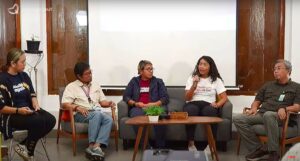
Deforestation in Papua goes on happening from time to time. Based on the record of Forest Watch Indonesia (FWI) compiled from the Ministry of Environment and Forestry (MoEF) data since 2017-2020, the use of production forests in Papua and West Papua has increased to more than 1 million hectare per year. On the other hand, the utilization of forests in Sumatera, Kalimantan, Nusa Tenggara, Maluku and Sulawesi extends over just hundred thousand hectares.
Meanwhile, from January to June 2020, EcoNusa research team monitoring through the Landsat and Sentinel imagery identified 1,669 hectares of forest loss due to land use change into palm oil estate. The size equals to 2,225 soccer field. The locations are spread over Merauke, Fakfak and Manokwari.
The condition is so nerve-wracking as Papuan forests are deemed the last frontier of rainforests in Indonesia. It requires serious action to protect forest through government official regulation as well as local wisdom.
Various efforts have been done to protect the existing forest areas in Tanah Papua. The Government of West Papua Province declared as the Conservation Province in 2015. It was then upgraded into the Declaration of Manokwari in 2018 with a commitment that West Papua to save 70 percent of the mainland as the protected areas.
Papua Province also took part in forest conservation in Tanah Papua. In addition to its support to the Declaration of Manokwari, Papua Province drafted Special Bylaws (Perdasus) No. 21/2008 on Sustainable Forest Management in Papua Province and Perdasus No. 23/2008 on Customary Rights and Individual Property Rights of the Indigenous People.
Papuan Forest, Breath of Life up to Indigenous People’s Spiritual Center
Talking about Papuan forests is an indivisible part of the topic on property rights of the indigenous people. The indigenous community has lived with forest from generation to generation on the tribal group division basis. Each tribe has their own customary land and thus has the rights to manage the existing areas and natural resources. One of the natural resources as the source of their livelihood is forest.
According to Derius Woloin, one of Bentara Papua volunteers and a native youth of Knasaimos Tribe in South Sorong Regency, West Papua, forests are the breath of Papuan life. From forests, people have their staple food, water spring, fresh air, building material and medicine.
“Destroying forests are akin to killing our biological mother. Forest, as if a mother, provides everything needed by the community for a long time,” said Derius on the Story of Papuan Forest Festival organized by Hutan Itu Indonesia on 13 September 2020. The event was a series of talk show on the updated info on Indonesian forests across from Sabang to Merauke.
Not merely a breath of life, the indigenous people in Tanah Papua has made forest as the center of their spiritual life as reflected from their traditional belief.
“People in Papua does not put mankind as the center of the universe. On contrary, the universe such as forest is the central of spiritual,” said Aloysius Number, EcoNusa’s Program Associate for Natural Resources Development, as one of the resource persons of the event.
For the reason, the indigenous community only gets benefits to suffice their needs despite the abundant resources from forests. Their respect to forest as part the nature is reflected from the various kinds of local wisdom that brings forward the spirit of ecological conservation.
Protecting Papuan Forest through Local Wisdom
One of the local wisdoms that brings out the spirit of environmental conservation is Sinara traditional ceremony. As to Aloysius, Sinara symbolizes a call for the ancestors’ blessing before doing something that utilizes natural resources such as boat construction, house construction, logging or land clearance for garden. Sinara is found in Kaimana, West Papua.
Aloysius added that, in addition to Sinara, another local wisdom to protect forest is the existence of the forbidden areas. People in Tanah Papua is accustomed to having rules on forbidden spots. He cited an example of the area of his origin which was derived from the protection of Cenderawasih, an endemic bird in Tanah Papua.
“In Kaimana, the areas in Bicari Bay are deemed forbidden spots because it is the habitat for Cenderawasih,” he added.
Derius shared similar issues. “Here we also have forbidden forest. It is only for the local leader or certain people that may enter the area. So far, nobody is allowed to do anything there.”
The existence of forbidden areas gives a sign to the local community to suffice their needs from forests appropriately. Some certain places of the forests are left untouched by human activities to ensure the sustainability. Local wisdom is worthy to be preserved to ensure forest protection in Papua from the mushrooming land conversion nowadays.
Editor: Leo Wahyudi and V. Arnila Wulandani







